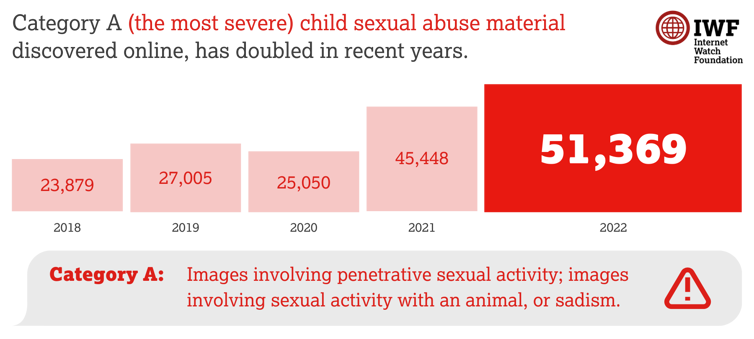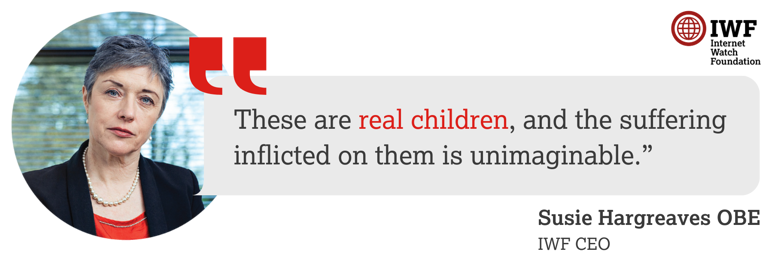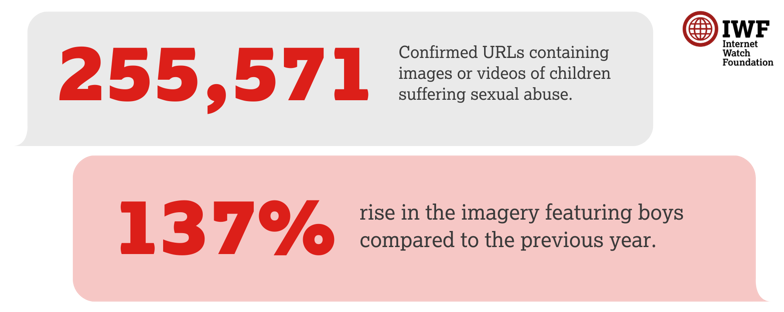
AI-generated videos of child sexual abuse a ‘stark vision of the future’
Real victims’ imagery used in highly realistic ‘deepfake’ AI-generated films

Published: Tue 25 Apr 2023

The amount of Category A child sexual material discovered online has doubled since 2020, with newborn babies and toddlers among the victims of the most severe kinds of sexual abuse, new data reveals.
The Internet Watch Foundation’s annual report, published today (April 25) shows that, in 2022, a record-breaking 51,369 of the webpages it took action to remove or block from the internet contained Category A child sexual abuse material.
This is the most severe kind of imagery, and can include the worst kinds of sexual abuse, including the rape of children, babies, and even newborns, as well as acts including bestiality, or sadism.
The amount of this kind of content has doubled since 2020 when the IWF uncovered 25,050 pages containing Category A abuse. The total number of URLs in 2022 containing Category A child sexual abuse material is higher than the IWF has ever seen before.
Proportionally, Category A material now accounts for 20 per cent of all the content the IWF sees – up from 18 per cent in 2021, and 17 per cent in 2020.
The IWF is the UK organisation responsible for tracking down child sexual abuse imagery online. It works alongside industry and law enforcement to make sure this content is swiftly removed from the internet.

Susie Hargreaves OBE, Chief Executive of the IWF, said: “We have seen criminals looking to exploit more and more insidious ways to profit from the abuse of children.
“I don’t think I can overstate the harm being done here. These are real children, and the suffering inflicted on them is unimaginable. They are being raped, and subjected to sexual torture, and criminals are making money off the back of that. It is truly appalling.
“Last year, we saw more of the most extreme kind of content online than ever before. Category A imagery can include some of the worst sexual acts being carried out against children.”
The rise in more extreme imagery is in part due to criminal sites looking to commercialise the sexual abuse and exploitation of children.
In 2020, the IWF found 12,900 commercial webpages dedicated to the sexual abuse of children. In 2022, this had more than doubled, with 28,933 webpages being identified as commercial child sexual abuse sites.

“Rosa”, a Senior Internet Content Analyst at the IWF*, said: “It is disturbing how matter-of-fact these sites are. Child sexual abuse is treated like a commodity on these sites.”
She added: “People are now only one click away from Category A material. That is a public safety issue. This extreme material is no longer in the creepy corners of the internet. It’s in plain sight.”
Security Minister Tom Tugendhat said: "Child sexual abuse is an abhorrent crime. It is paramount that the perpetrators of this abuse are identified and brought to justice. The Internet Watch Foundation’s work is vital in tackling child sexual abuse material online, and cracking down on offenders who seek to profit from young people’s pain.
“I am proud to be working alongside the Internet Watch Foundation to ensure that industry partners such as social media companies take sufficient steps to tackle child sexual abuse online.
"Most importantly, companies need to ensure that features such as end-to-end encryption have the necessary safety features built in so that they do not blind themselves to abuse occurring on their platforms.”
Mr Ian Critchley QPM, National Police Chiefs' Council lead for Child Protection and Abuse Investigations said: “The IWF’s work is so important in enabling police to really understand the offending that is going on.
“We know that we have new crime types to deal with all the time, and we know that criminals will stop at nothing to exploit and abuse children for their own gain, making money from the most awful acts of abuse.
“The rise in the most severe offending being found is deeply disturbing - not only are all internet users far more likely to be exposed to this harmful material, but it demonstrates once again how criminals have no regard for the lifelong harm it causes these children. If you are viewing such material, be in no doubt – this is not a victimless crime. These are real children.
“We would urge the public not to click on unknown or suspicious links -and – if you are exposed to such material, to report it, so that IWF can remove it."
These sites are typically not hosted by mainstream hosting companies, instead mainly being found on servers in little-known companies based in Europe or Asia.
The process to get these sites taken down is not easy but the IWF works hard to track them down and have them removed.
The data shows some of the very worst sexual abuse the IWF finds is being perpetrated upon the youngest, most helpless children, with babies and toddlers being subjected to acts including rape and sexual torture.
In 2022, 81 per cent (810 URLs) of URLs containing the sexual abuse of 0-2 year old children contained Category A material.
As well as this, 50 per cent of the imagery of 3-6 year olds (5,622 URLs) was deemed to contain Category A material.

In total in 2022, the IWF confirmed 255,570 URLs contained images or videos of children suffering sexual abuse.
The majority (96 per cent or 242,989 instances) of the imagery found shows girls, but there has been a 137 per cent rise in the imagery featuring boys compared to the previous year (2,641 instances in 2021, compared to 6,253 in 2022).
While analysts are finding more criminal content online than ever before, there has also been an upsurge in private companies looking to protect their customers from criminal content online.
Victoria Green, CEO of the Marie Collins Foundation, a charity dedicated to helping victims of technology-assisted child sexual abuse, said: “Child sexual abuse is not new. What is new is the accessibility to children that technology both enables and facilitates.
“These statistics show the horror that is being done to our children under our very noses. It highlights the lengths that people who want to use children for their own sexual and/or financial satisfaction will go to. As a society we enable this to continue to happen and it is time we opened our eyes to the reality that our prevention strategies to date have not worked.
“The time is now to have the honest conversations about how to challenge the context that allows child sexual abuse to happen. The time is now to accept the responsibilities we have to support victims to recover. The time is now to act.”
The IWF had 181 Members helping them in the fight against online child sexual abuse material at the end of 2022 – a record for IWF.
Earlier this year, Marriott International, Inc. joined the IWF with the goal of blocking websites containing CSAM from guest internet access in its hotels. The collaboration is the first of its kind for the hotel industry. One of the Marriott’s stated aims was to address a “critical human rights issue for the industry”.
Ms Hargreaves added: “In a year where we’re finding more imagery of the most severe types of sexual abuse, we’re also seeing more and more companies from around the world showing their determination to do something about it.
“We’ve had companies operating in sectors we’ve not worked with before. Whether it’s down to the move towards more regulation in parts of the globe, or a genuine desire to make the internet a safer place for all, it’s a positive sign.”
Mr Critchley said tackling the spread of child sexual abuse imagery will need as many organisations as possible to work together. He urged online platforms not to introduce measures, like end-to-end encryption, which may make detection of criminal content more difficult.
He said: “The prevention of online child sexual abuse will take all of society to step forward. I urge you to join us as we fight to keep children safe - and this includes the tech companies and platforms who have a moral and legal duty to keep children safe, and must not allow End-to-End encryption stop us from identifying and removing this abuse.
“We are committed to targeting the perpetrators of these crimes and bringing them to justice, and I am grateful and proud to work with committed, professional people – at the IWF, my police colleagues, and other partners, who see some of the worst abuse an adult can do to a child in order to safeguard children and bring offenders to justice.
“If you read this, and are concerned about your own thoughts and behaviour, you can stop. The consequences of offending can last a lifetime. Seek help, now.”
Data from every report the IWF investigates is used in services which are deployed to tech companies under a strict licence in order to stop the upload, sharing and distribution of this imagery.
The IWF also works with companies to disrupt the commercialisation of child sexual abuse material.
The IWF works with some of the giants of the internet world, through to smaller and newer companies within the internet industry.
By working with these companies, the IWF can work to have this harmful material removed from the internet and blocked from being accessed, shared, or uploaded again in the future.
In Total:
Read the full report here.

Real victims’ imagery used in highly realistic ‘deepfake’ AI-generated films